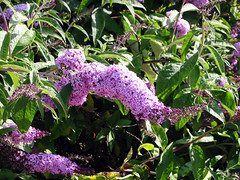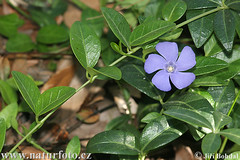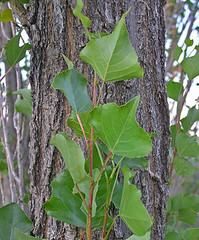Thursday, March 5, 2009
Invasive and Risk Exotic Plants Found
Comprehensive Spreadsheet of Invasive and Exotic Plants
(Listed By PSU Block)
General Species Information:
Name: Bamboo spp.

Invasive Status: Potentially invasive
Description: A group of woody perennial evergreen plants in the true grass family Poaceae, subfamily Bambusoideae, tribe Bambuseae. There are more than 70 genera divided into about 1,000 species. They occur across East Asia, west to India and the Himalayas, in sub-Saharan Africa, from the Southeastern United States south to Argentina and Chile. Bamboos on campus are mainly Heavenly Bamboo (Nardina domestica), Fountain Bamboo (Fargesia nitida), Golden Bamboo (Phyllostachys aruea’koli’), Dwwarf Whitestripe Bamboo (Pleioblastus variegatus), Palcuate Bamboo (Sasa palmate), Bamboo (Sasa veitchii), Black Bamboo (Phyllostachys nigra) and Sweetshoot Bamboo (Phyllostachys dulcis). Bamboo has not aroused enough awareness to be defined as invasive yet, but several researches and studies found it aggressive in the Pacific Northwest.
Invasive Characteristic: Fast growing and spreading.
Photo Credit: Steve's Forestry Blog
http://z.about.com/d/forestry/1/0/g/j/bamboo_thicket.jpg
Description: A group of woody perennial evergreen plants in the true grass family Poaceae, subfamily Bambusoideae, tribe Bambuseae. There are more than 70 genera divided into about 1,000 species. They occur across East Asia, west to India and the Himalayas, in sub-Saharan Africa, from the Southeastern United States south to Argentina and Chile. Bamboos on campus are mainly Heavenly Bamboo (Nardina domestica), Fountain Bamboo (Fargesia nitida), Golden Bamboo (Phyllostachys aruea’koli’), Dwwarf Whitestripe Bamboo (Pleioblastus variegatus), Palcuate Bamboo (Sasa palmate), Bamboo (Sasa veitchii), Black Bamboo (Phyllostachys nigra) and Sweetshoot Bamboo (Phyllostachys dulcis). Bamboo has not aroused enough awareness to be defined as invasive yet, but several researches and studies found it aggressive in the Pacific Northwest.
Invasive Characteristic: Fast growing and spreading.
Photo Credit: Steve's Forestry Blog
http://z.about.com/d/forestry/1/0/g/j/bamboo_thicket.jpg
PSU Location: Stanford Building/Science One (242), Cramer Hall (201), Shattuck Hall (198)
Name: Broom species Cytisus spp.

Invasive Status: Oregon: Class B Noxious Weed, Washington: Class A, B Noxious Weed
Description: Shrub, small, numerous trifoliate leaves. Many yellow pea shaped flowers.
Invasive Characteristics: Forms dense stands, crowds out natives.
Photo Credit: King County Washington
PSU Location: Epler Hall (269)
Name: Butterfly Bush Buddleia davidii
Invasive Status: Oregon, Washington: Class B Noxious Weed
Description: Shrub. Narrow green to blue-green leaves. Dense clusters of showy flowers. Flowers are small and white to pink to purple in color.
Invasive Characteristics: Aggressive, outcompetes native plants. Forms monocultures.
Photo Credit: Tom Forney, Oregon Department of Agriculture
PSU Location: Helen Gordon Center (301)—technically outside of our study area
Name: Chinese Wisteria Wisteria sinensis
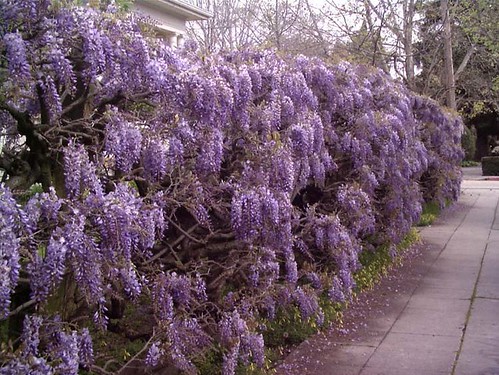
Invasive Status: Invasive in the eastern United States
Description: A woody, deciduous, perennial climbing vine, growing to 20-30 m long over supporting trees.
Leaves are shiny, green, pinnately compound. All parts of the plant contain a glycoside called wisterin which is toxic and may cause nausea, vomiting, stomach pains and diarrhea.
Invasive Characteristic: It’s tolerant of shade. It can displace native vegetation and kill tress and shrubs by girdling them, thus change the structure of a forest and alter the light availability to the forest floor.
Photo Credit: Along the Garden Path
http://alongthegardenpath.wordpress.com/plant-profiles/wisteria/
PSU Location: Blackstone/Simon Benson House/Montgomery Court (229), Parking Structure 3 (302, outside of study area)
Name: Common Rush Juncus effusus L.
Invasive Status: Can become very invasive in marsh areas and swamps in Pacific Northwest- Now found in most of the lower 48 and Canada.
Description: It grows in large clumps about 1.5 meters (5 feet) tall at the water’s edge along streams and ditches, but can be invasive anywhere with moist soil. It is commonly found growing in humus-rich areas like marshes, ditches, fens, and beaver dams. The stems are smooth cylinders with light pith filling. The yellowish inflorescence appears to emerge from one side of the stem about 20 cm from the top. The lower leaves are reduced to a brown sheath at the bottom of the stem.
Invasive Characteristics: Resilient to disease and pest problems, extremely hardy and adaptable
Photo Credit: Burke Museum of Natural History c Fred Weinmann
PSU Locations: Peter W. Scott Center (231)
Name: Creeping St. Johnswort Hypericum calycinum
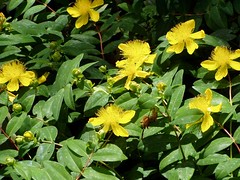
Invasive Status: Not listed in Oregon, Washington, or California. Noted in ornamental descriptions as potentially invasive.
Description: Evergreen groundcover, grows to 12 inches. Opposite leaves are rich green. Bright yellow flowers have many protruding yellow stamens.
Invasive Characteristics: Highly adaptable groundcover, spreads vigorously in both sun and shade with underground stolons. Tolerates a wide range of soil conditions.
Photo Credit: Missouri Botanical Gardens
PSU Location: Broadway Building (193), Miller Library (230), & West Hall/Joseph C. Bumel Hall (268)
Name: Dwarf Periwinkle Vinca minor
Invasive Status: Invasive in North America
Description: A trailing subshrub, occasionally scrambling up to 40 cm high but never twining or climbing. Leaves are evergreen, glossy dark green with a leathery texture and an entire margin.
Invasive Characteristic: It forms dense and intensive mats along forest floors that exclude native vegetation.
Photo Credit: Jiri Bohdal
http://www.naturfoto.cz/jiri-bohdal.html
PSU Location: Broadway Building (193), Shattuck Hall (198), Neuberger Hall (199), Miller Library (230), Science Building 2 (241), West Hall/Joseph C. Bumel Hall (268), Stephen Epler Hall (269), Peter W. Scott Center Field (270), Helen Gordon Center (301), Parking Structure 3 (302)
Name: English Holly Ilex aquifolium
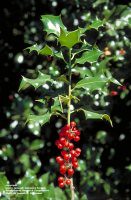
Invasive Status: Invasive in Oregon, other Pacific Northwest states. Listed by the City of Portland as a nuisance plant.
Description: Evergreen shrub or small tree, grows to 20 ft. Leaves are thick and spiny and may have prickles along edges. Female plants bear bright red berries, which are toxic to humans. Commonly used in holiday decorations.
Invasive Characteristics: Produces many seeds which germinate quickly and can establish in pristine or disturbed forest habitats. Birds and small mammals disperse the seeds when using the berries as a food source.
Photo Credit: California Invasive Plant Council
PSU Location: University Services/Parking Structure 2 (189) & Peter W. Scott Center (231)
Name: English Ivy Hedera helix

Invasive Status: Invasive in Oregon and other Pacific Northwest states, Oregon Class B, Washington Class C, City of Portland Prohibited Plant.
Description: Woody, perennial vine with 2 distinct growth forms – creeping understory vine and shrubby reproductive form. Understory vine leaves are thick and waxy with three lobes. Reproductive form leaves are also thick and waxy but usually diamond-shaped. Small white flowers are in tight clusters and berries are purple.
Invasive Characteristics: Reproduces through root and stem fragments and through seed dispersal facilitated by birds. English ivy can form a thick canopy that can smother trees, encourage tree rot, increase fire hazard, harbor pests, and prevent native seedling establishment.
Photo Credit: The Nature Conservancy
PSU Location: Sixth Avenue Building (159), University Services/Parking Structure 2 (189), Parking Structure One (191), Shattuck Hall (198), Cramer Hall (201), Lincoln Hall (202), Harder House/Parkway Building/School of Extended Studies (227), Blackstone/Simon Benson House/Montgomery Court (229), Peter W. Scott Center (231), Science Building Two (241), Stanford Building/Science Building One (242), & University Honors Building (267).
Name: English Laurel Prunus laurocerasus 'Otto Luyken'
Invasive Status: Invasive in United Kingdom and Northwest of the United States
Description: Evergreen shrub or small tree, grows to 5-13-m tall, rarely to 18 m tall, with a trunk up to 60-cm
broad. Leaves are dark green, leathery. Easily confused with the true laurel (Laurus nobilis, Lauraceae).
Invasive Characteristic: Its rapid growth, coupled with its evergreen habit and its tolerance of drought and shade, often allows it to out-compete and kill off native plant species.
Photo Credit:Washington State University Clark County Extension
PSU Location: Shattuck Hall (198), Stephen Epler Hall (269), Parking Structure 3 (302)
Name: Honey Locust Gleditsia triacanthos
Invasive Status: Not listed in Oregon, Washington, or California. Native to the eastern US, but can be invasive in California and other Pacific Northwest states.
Description: Long-lived deciduous tree, grows to 75 ft. Member of the Fabaceae family with characteristic pinnately compound leaves. Produces many long seed pods with up to 39 seeds.
Invasive Characteristics: Produces many seeds which can remain viable for long periods. Reproduces readily from stump and root sprouts. Tolerant of flooding, droughts, and some soil salinity.
Photo Credit: The Nature Conservancy
PSU Location: Playground Park Block (197)
Name: Japanese Barberry Berberis thunbergii
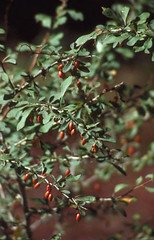
Invasive Status: Invasive in Eastern US. Currently not present in the Pacific Northwest in natural settings.
Description: Deciduous shrub with dense branching and small oval leaves. Leaf color ranges from green to blue-green to reddish-purple. Yellow flowers in the spring with red fruits maturing in the summer, often persisting through the winter.
Invasive Characteristics: Forms dense stands, which displaces native plants and reduces wildlife forage and habitat. It also alters soil pH and biological activity in the soil.
Photo Credit: Jil M. Swearingen, US National Park Service
PSU Location: Community Rec Field (239)
Invasive Status: Not listed in Oregon, Washington, or California. Native to the eastern US, but can be invasive in California and other Pacific Northwest states.
Description: Long-lived deciduous tree, grows to 75 ft. Member of the Fabaceae family with characteristic pinnately compound leaves. Produces many long seed pods with up to 39 seeds.
Invasive Characteristics: Produces many seeds which can remain viable for long periods. Reproduces readily from stump and root sprouts. Tolerant of flooding, droughts, and some soil salinity.
Photo Credit: The Nature Conservancy
PSU Location: Playground Park Block (197)
Name: Japanese Barberry Berberis thunbergii

Invasive Status: Invasive in Eastern US. Currently not present in the Pacific Northwest in natural settings.
Description: Deciduous shrub with dense branching and small oval leaves. Leaf color ranges from green to blue-green to reddish-purple. Yellow flowers in the spring with red fruits maturing in the summer, often persisting through the winter.
Invasive Characteristics: Forms dense stands, which displaces native plants and reduces wildlife forage and habitat. It also alters soil pH and biological activity in the soil.
Photo Credit: Jil M. Swearingen, US National Park Service
PSU Location: Community Rec Field (239)
Name: Lombardy Poplar Populus nigra
Invasive Status: Has spread throughout U.S., but not considered an invasion threat.
Description: Lombardy poplar trees are best known for their columnar form and unusual branching structure.
Their branches start close to the ground and parallel the trunk. Lombardy poplars will reach 40'-50' in height, with a spread of 10'-15'. The fall foliage of Lombardy poplar trees is yellow. The bark is grey/green on young trees and new growth, but becomes black, thickened, and furrowed on older, larger trunks.
Invasive Characteristics: Performs well in damp areas and drought, is fast growing, however, very susceptible to disease (little invasive potential).
Photo Credit: Al Schneider
www.swcoloradowildflowers.com/
PSU Locations: Blackstone/Simon Benson House/Montgomery Court (229)
Name: Norway Maple Acer platanoides
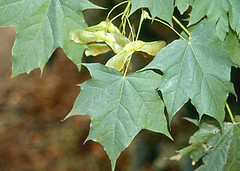
Invasive Status: Invasive in Eastern US
Description: Deciduous tree, grows to 60 ft. Leaves are palmate, with 5 lobes and are a glossy dark green. Like other maple’s, seeds are held in helicopter shaped fruits. Easily confused with other maple species, especially the sugar maple (Acer saccharum).
Invasive Characteristics: Produces many seeds which germinate quickly and can crowd out native species.
Photo Credit: Pat Breen, Oregon State University
PSU Location: Along Broadway—Public Safety Building to Lincoln Hall (blocks 197, 198, 199, 200, 201, 202) Harrison Street Building (240), Science Building One (242), Bumel Hall (268)
Name: Sweet woodruff Galium odoratum

Invasive Status: Invasive in Oregon, other Pacific Northwest states. Listed by the City of Portland as a nuisance plant.
Description: Perennial, procumbent herb, grows to 12 inches. Whorled leaves are fine-textured and deep green. Clustered flowers are white and produce small fruits.
Invasive Characteristics: Spreads through rooting stems. Noted to be invasive under conditions where moisture is adequate during the summer.
Photo Credit: Oregon State University
PSU Location: Blackstone/Simon Benson House/Montgomery Court (229)
Name: Vossi Goldenchain Tree Laburnum anagyroides
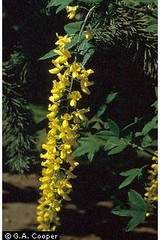
Invasive Status: Present in California, Utah, Washington and NW Canada
Description: This tree is a hybrid of L. alpinium and L anagyroides, both species of southern Europe. This vase-shaped tree grows about 10 to 15 feet high in cultivation. Short-lived, pealike, yellow blossoms, 6 to 10 inches long, cascade from its branches. Its bright green foliage is composed of three leaflets, and the bark is pleasantly olive green.
Invasive Characteristics: Moderate growth rate, resistant to predation due to poisonous foliage and fruit.
Photo Credit: USDA Plants Database c G A Cooper
PSU Location: Shattuck Hall (198)
Name: Yellow Flag Iris Iris pseudacorus
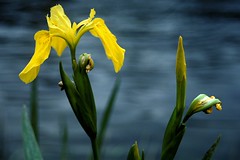
Invasive Status: Found throughout the U.S. and Canada- still commonly sold for ornamental use or erosion control
Description: Yellow Flag Iris is a monocot, forb, perennial, forming dense stands of robust plants. It has stout rhizomes, 1-4 cm in diameter and its roots are 10-30 cm long. They have large, showy, bisexual flowers which are pale to deep yellow.
Invasive Characteristics: Iris pseudacorus is a fast-growing and fast-spreading invasive plant that can outcompete other wetland plants, forming almost impenetrable thickets.
Photo Credit: TNC Invasive Species Program
PSU Locations: Visitor Parking/Tennis Court (197), Stanford Building/Science Building One (242)
Subscribe to:
Posts (Atom)

